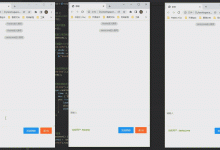一、缓冲流
1、介绍
缓冲流:不能直接作用在文件上,需要包一层,它是一种处理流。用于提高文件的读写效率。它在流的基础上对流的功能进行了增强。提高读写速度的原因:内部提供了一个缓冲区。缺省使用 8192 个字节(8Kb)的缓冲区 。
源码示例:BufferedInputStream
1 public class BufferedInputStream extends FilterInputStream {2 // 默认缓冲区的大小3 private static int DEFAULT_BUFFER_SIZE = 8192;4 }

要求:先关闭外层的流,再关闭内层的流。而关闭外层流的同时,内层流也会自动的进行关闭。关于内层流的关闭,可以省略。
2、BufferedInputStream,BufferedOutputStream(字节流的缓冲区)
代码示例:用字节流缓冲区处理非文本文件(图片,视频等)。缓冲流复制图片。
1 // 文件:F:\\\\hello.jpg2 public class Main {34 public static void main(String[] args) {5 try (// 造节点流6ad8FileInputStream fis = new FileInputStream((new File(\"F:\\\\hello.jpg\")));7 FileOutputStream fos = new FileOutputStream(new File(\"F:\\\\hello_1.jpg\"));8 // 造缓冲流9 BufferedInputStream bis = new BufferedInputStream(fis);10 BufferedOutputStream bos = new BufferedOutputStream(fos);) {1112 byte[] buffer = new byte[1024];13 int len;14 while ((len = bis.read(buffer)) != -1) {15 bos.write(buffer, 0, len);16 }1718 // 刷新缓冲区.必须19 // bos.flush();20 } catch (Exception e) {21 }22 }23 }2425 // 用于copy 3.64G 的文件花费 18.925s
3、BufferedReader、BufferedWriter(字符流的缓冲区)
BufferedReader:从字符输入流中读取文本,缓冲各个字符,从而实现字符、数组和行的高效读取。可以指定缓冲区的大小,或者使用默认的大小。在大多数情况下,默认值就足够大了。
字符读取流缓冲区,该缓冲区提供了一个一次读一行的方法readLine(),方便于对文本数据的获取。当返回null时,表示读到文件末尾。
BufferedWriter:将文本写入字符输出流,缓冲各个字符,从而提供单个字符、数组和字符串的高效写入。可以指定缓冲区的大小,ad0或者接受默认的大小。在大多数情况下,默认值就足够大了。
该缓冲区中提供了一个跨平台的换行符:newLine()。
代码示例:用字符流缓冲区处理文本文件。缓冲流复制文本文件。
1 // 文件:F:\\\\hello.txt2 // 内容:任意34 // 方式一:会自动换行5 public class Main {67 public static void main(String[] args) {8 try ( // 造节点流9 FileReader fr = new FileReader(new File(\"F:\\\\hello.txt\"));10 FileWriter fw = new FileWriter(new File(\"F:\\\\hello_1.txt\"));1112 // 造缓冲流13 BufferedReader br = new BufferedRead3b9cer(fr);14 BufferedWriter bw = new BufferedWriter(fw);) {1516 // 使用char[]数组17 char[] cbuf = new char[1024];18 int len;19 while ((len = br.read(cbuf)) != -1) {20 bw.write(cbuf, 0, len);21 }2223 // bw.flush();24 } catch (Exception e) {25 }26 }27 }282930 // 方式二:不会自动换行31 public class Main {3233 public static void main(String[] args) {34 try ( // 造节点流35 FileReader fr = new FileReader(new File(\"F:\\\\hello.txt\"));36 FileWriter fw = new FileWriter(new File(\"F:\\\\hello_1.txt\"));3738 // 造缓冲流39 BufferedReader br = new BufferedReader(fr);40 BufferedWriter bw = new BufferedWriter(fw);) {4142 // 使用readLine(),一次性读一行43 String data;44 while ((data = br.readLine()) != null) {45 // data中不包含换行符,读一行写一行,不会自动换行.若想换行,可以:46 // 方法一:47 // bw.write(data + \"\\n\");4849 // 方法二:50 bw.write(data);51 bw.newLine();52 }5354 // bw.flush();55 } catch (Exception e) {56 }57 }58 }
4、装饰设计模式
自定义的字符读取流缓冲区myReadLine(),将readLine()方法实现了一次。
代码示例:
1 class MyBufferedReader {2 private final FileReader fileReader;34 public MyBufferedReader(FileReader fileReader) {5 this.fileReader = fileReader;6 }78 public String myReadLine() throws IOException {9 StringBuilder builder = new StringBuilder();1011 int len;12 while ((len = fileReader.read()) != -1) {13 if (len == \'\\r\') {14 continue;15 }16 if (len == \'\\n\') {17 return builder.toString();18 }1920 builder.append((char) len);21 }2223 if (builder.length() != 0) {24 return builder.toString();25 }2627 return null;28 }2930 public void myClose() {31 try {32 fileReader.close();33 } catch (IOException e) {34 e.printStackTrace();35 }36 }37 }3839 // 注意关闭资源40 // 文件:F:\\\\hello1.txt41 // 内容:42 我有a dream!43 you need to have a dream!我有a dream!44 you need to have a dream!45 public class Main {46 public static void main(String[] args) throws Exception {47 MyBufferedReader reader = new MyBufferedReader(new FileReader(new File(\"F:\\\\hello1.txt\")));4849 String temp;50 while ((temp = reader.myReadLine()) != null) {51 System.out.println(temp);52 }5354 reader.myClose();55 }56 }5758 // 结果.打印正常
二、转换流
1、介绍
转换流提供了在字节流和字符流之间的转换。
InputStreamReader:将InputStream转换为Reader,实现将字节的输入流按指定字符集转换为字符的输入流。解码。
OutputStreamWriter:将Writer转换为OutputStream,实现将字符的输出流按指定字符集转换为字节的输出流。编码。
很多时候使用转换流来处理文件乱码问题。实现编和解码的功能。

2、InputStreamReader
每次调用InputStreamReader中的一个read()方法都会导致从底层输入流读取一个或多个字节。要启用从字节到字符的有效转换,可以提前从底层流读取更多的字节,使其超过满足当前读取操作所需的字节。
为了达到最高效率,可要考虑在InputStreamReader外套接一层BufferedReader。
键盘录入的标准写法:BufferedReader in = new BufferedReader(new InputStreamReader(System.in))
代码示例:读文件。字节流->字符流
1 public class Main {23 public static void main(String[] args) {4 try (FileInputStream fis = new FileInputStream(new File(\"F:\\\\hello.txt\"));5 InputStreamReader isr = new InputStreamReader(fis, \"UTF-8\");) {67 char[] cbuf = new char[1024];8 int len;9 while ((len = isr.read(cbuf)) != -1) {10 String str = new String(cbuf, 0, len);11 System.out.print(str);12 }1314 } catch (Exception e) {15 }16 }17 }
代码示例:读键盘。缓冲流
1 public class Main {23 public static void main(String[] args) {4 try (// 从标准键盘输入.5 BufferedReader reader = new BufferedReader(new InputStreamReader(System.in));) {67 String linad8e = null;8 while ((line = reader.readLine()) != null) {9 if (\"over\".equals(line)) {10 return;11 }12 System.out.println(line);13 }14 } catch (Exception e) {15 }16 }17 }
3、OutputStreamWriter
每次调用write()方法都会导致在给定字符(或字符集)上调用编码转换器。在写入底层输出流之前,得到的这些字节将在缓冲区中累积。可以指定此缓冲区的大小,不过,默认的缓冲区对数用途来说已足够大。注意,传递给write()方法的字符没有缓冲。
为了获得最高效率,可考虑在OutputStreamWriter外套接一层BufferedWriter。以避免频繁调用转换器。例:
Writer out = new BufferedWriter(new OutputStreamWriter(System.out))
代码示例:写文件。字符流->字节流
1 public class Main {23 public static void ma3a6bin(String[] args) {4 try (FileInputStream fis = new FileInputStream(new File(\"F:\\\\hello.txt\"));5 FileOutputStream fos = new FileOutputStream(new File(\"F:\\\\hello_1.txt\"));67 InputStreamReader isr = new InputStreamReader(fis, \"UTF-8\");8 OutputStreamWriter osw = new OutputStreamWriter(fos, \"gbk\");) {910 char[] cbuf = new char[1024];11 int len;12 while ((len = isr.read(cbuf)) != -1) {13 osw.write(cbuf, 0, len);14 }1516 isr.close();17 osw.close();18 } catch (Exception e) {19 }20 }21 }
代码示例:读\\写键盘。缓冲流
1 public class Main {23 public static void main(String[] args) {4 try (BufferedReader reader = new BufferedReader(new InputStreamReader(System.in));5 BufferedWriter writer = new BufferedWriter(new OutputStreamWriter(System.out));) {67 String line = null;8 while ((line = reader.readLine()) != null) {9 if (\"over\".equalsIgnoreCase(line)) {10 break;11 }12 writer.write(line.toUpperCase());13 writer.newLine(); // 换行14 writer.flush();15 }1617 reader.close();18 writer.close();19 } catch (Exception e) {20 }21 }22 }
4、字符集
ASCII:美国标准信息交换码。用一个字节的7位可以表示。
ISO8859-1:拉丁码表。欧洲码表。用一个字节的8位表示。
GB2312:中国的中文编码表。最多两个字节编码所有字符
GBK:中国的中文编码表升级,融合了更多的中文文字符号。最多两个字节编码
Unicode:国际标准码,融合了目前人类使用的所有字符。为每个字符分配唯一的字符码。所有的文字都用两个字节来表示。
UTF-8:变长的编码方式,可用1-4个字节来表示一个字符。
 爱站程序员基地
爱站程序员基地


